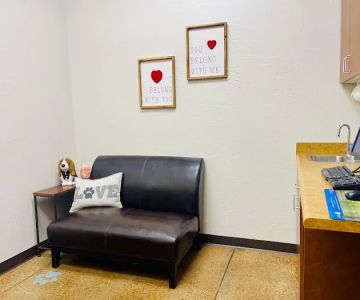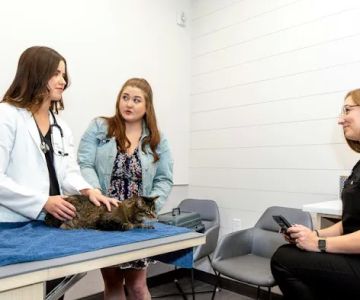Understanding Pet Anxiety When You Leave for Work
Many pet owners face the heartbreaking moment of seeing their dogs or cats panic when they pick up their keys or put on their shoes. This condition, known as separation anxiety, affects a large number of pets, especially dogs who thrive on companionship and routine. Understanding why your pet reacts this way is the first step in managing their emotions. Pets associate your absence with uncertainty—some worry you won’t return, while others become anxious simply because their daily structure changes. Recognizing this behavior as anxiety, rather than disobedience, can completely change how you approach the situation.
Veterinarians at Hidden Brook Veterinary explain that anxiety triggers are often connected to environmental cues—such as the sound of the garage door, jingling keys, or your morning alarm. Over time, pets develop a conditioned response, associating these signals with loneliness. The good news is that with patience, training, and structure, you can help your furry friend feel more secure when you’re away.
Common Signs of Separation Anxiety in Pets
Pet anxiety manifests in various ways, depending on the animal’s temperament and environment. Recognizing the early signs can prevent long-term behavioral issues and even protect your home from damage.
1. Destructive behavior
Chewed furniture, scratched doors, and torn pillows are often signs of stress rather than misbehavior. Pets channel their anxiety into physical actions as a coping mechanism. Dogs might dig near doors, while cats may over-groom or claw excessively.
2. Excessive vocalization
Continuous barking, whining, or meowing after you leave signals that your pet is distressed. This type of vocal anxiety is common in dogs that struggle with being alone. Neighbors often report this behavior first, which can indicate that your pet feels unsafe or abandoned.
3. Loss of appetite and pacing
Some pets stop eating when you’re gone, or they pace near windows and doors, waiting for your return. These are clear indicators of emotional discomfort. Cats, in particular, might hide for hours until they sense you’re back home, avoiding interaction with other animals or family members.
How to Help Your Pet Cope When You Leave for Work
Managing pet anxiety isn’t about eliminating the behavior overnight—it’s about building trust and creating a stable, calming environment. With consistency and compassion, your pet can learn that your departure doesn’t mean danger or abandonment.
1. Create a predictable routine
Animals find comfort in predictability. Establish a consistent schedule for feeding, walking, and playtime. When pets know what to expect, they’re less likely to feel nervous when something changes temporarily—like your absence during work hours. Consistency helps them understand that you always come back.
2. Gradual desensitization
Try short absences at first. Step out for a few minutes, then return calmly without dramatic greetings. Gradually increase the duration of your time away. This technique helps your pet associate your departures with normality instead of stress. Avoid emotional goodbyes, which can heighten their anxiety.
3. Comfort through environment
Leave comforting items around the house—such as your worn t-shirt, favorite blanket, or their favorite toy. These familiar scents create emotional security. Playing soft background music or leaving the TV on can also make your pet feel less alone by masking outside noises that trigger anxiety.
4. Provide mental and physical stimulation
Boredom can amplify stress. Before leaving, engage your pet with a brisk walk, puzzle toy, or interactive play. A tired pet is a relaxed pet. Food-dispensing toys or frozen treats can keep them mentally occupied while you’re away. For cats, consider window perches or automated toys that simulate hunting behavior.
Real-Life Story: Max’s Journey to Calm
Max, a two-year-old Labrador, used to howl for hours after his owner, Lisa, left for work. He chewed on shoes, scratched the door, and refused to eat until she came back. Frustrated and worried, Lisa turned to Hidden Brook Veterinary for advice. The vet recommended a combination of desensitization training and positive reinforcement. Lisa started leaving Max for short intervals, rewarding him for calm behavior. She also introduced a morning exercise routine and provided puzzle feeders during the day. Within weeks, Max’s destructive behavior stopped, and he began resting peacefully while Lisa was at work. His transformation shows how structured training and compassion can ease even the most anxious pets.
When Professional Help Is Needed
Sometimes, anxiety can be severe enough to require professional guidance. If your pet shows extreme distress—such as self-harm, aggression, or prolonged depression—it’s time to consult a veterinarian or animal behaviorist. Professionals may suggest pheromone diffusers, anxiety wraps, or in certain cases, short-term medication to help your pet adjust.
Experts at Hidden Brook Veterinary emphasize that treatment should always be tailored to your pet’s individual needs. A veterinarian can evaluate whether the anxiety stems from emotional, medical, or environmental causes. For instance, older dogs may experience separation stress due to cognitive decline, requiring a different care approach than a young, energetic pup.
Building Confidence and Trust Over Time
The goal of handling pet anxiety is to replace fear with confidence. Reinforce calm behavior with positive rewards rather than punishment. Every small success—such as staying calm while you grab your keys—should be acknowledged. Over time, your pet will start associating your departure with good things rather than distress.
Training takes patience, but consistency always pays off. In most cases, pets begin to settle within a few weeks once they realize that you always return. Remember, emotional support, structure, and gentle reinforcement go a long way in helping your furry friend feel secure.
Expert Advice from Hidden Brook Veterinary
According to Hidden Brook Veterinary, pet anxiety is one of the most common behavioral issues among modern households—especially as pet owners return to in-office work after remote schedules. Their veterinary team suggests combining behavioral training with environmental enrichment to create long-term results. They also recommend checking for underlying medical issues that could worsen anxiety, such as thyroid imbalances or joint pain in older pets.
If your pet continues to struggle with anxiety despite consistent training, scheduling a consultation with a professional is the best step forward. Hidden Brook Veterinary provides expert guidance on behavior modification, anxiety management, and holistic care to ensure pets live balanced, stress-free lives.
Helping Your Pet Thrive While You’re Away
Learning how to handle pet anxiety when leaving for work is about understanding and empathy. Your pet’s anxiety is not a flaw—it’s a reflection of the strong bond they share with you. With structure, patience, and expert veterinary advice, your pet can learn to feel safe and confident, even in your absence. Whether it’s a playful morning routine or creating a soothing environment, each small effort builds trust. Over time, you’ll not only ease your pet’s stress but also strengthen the loving connection that makes them part of your family.












